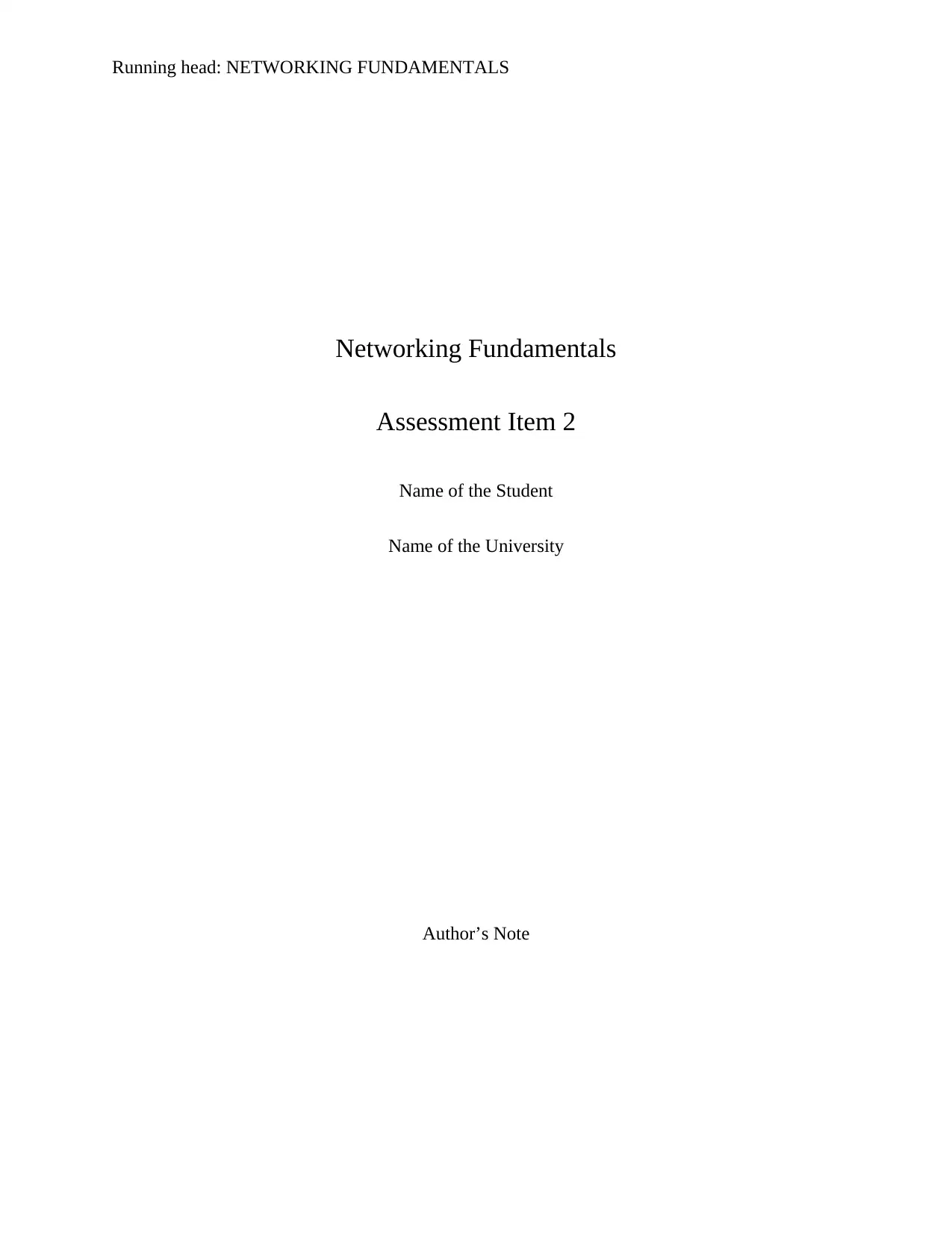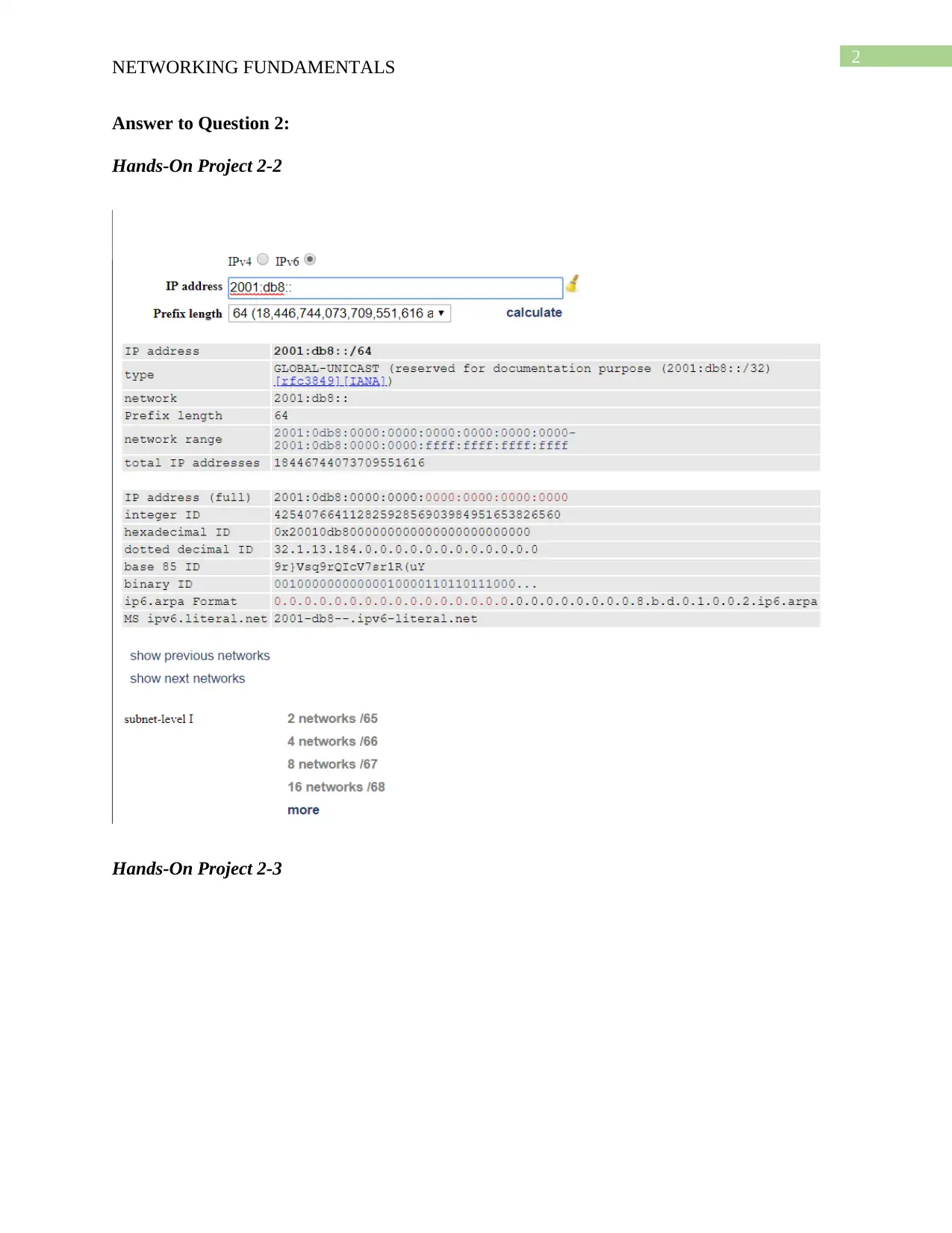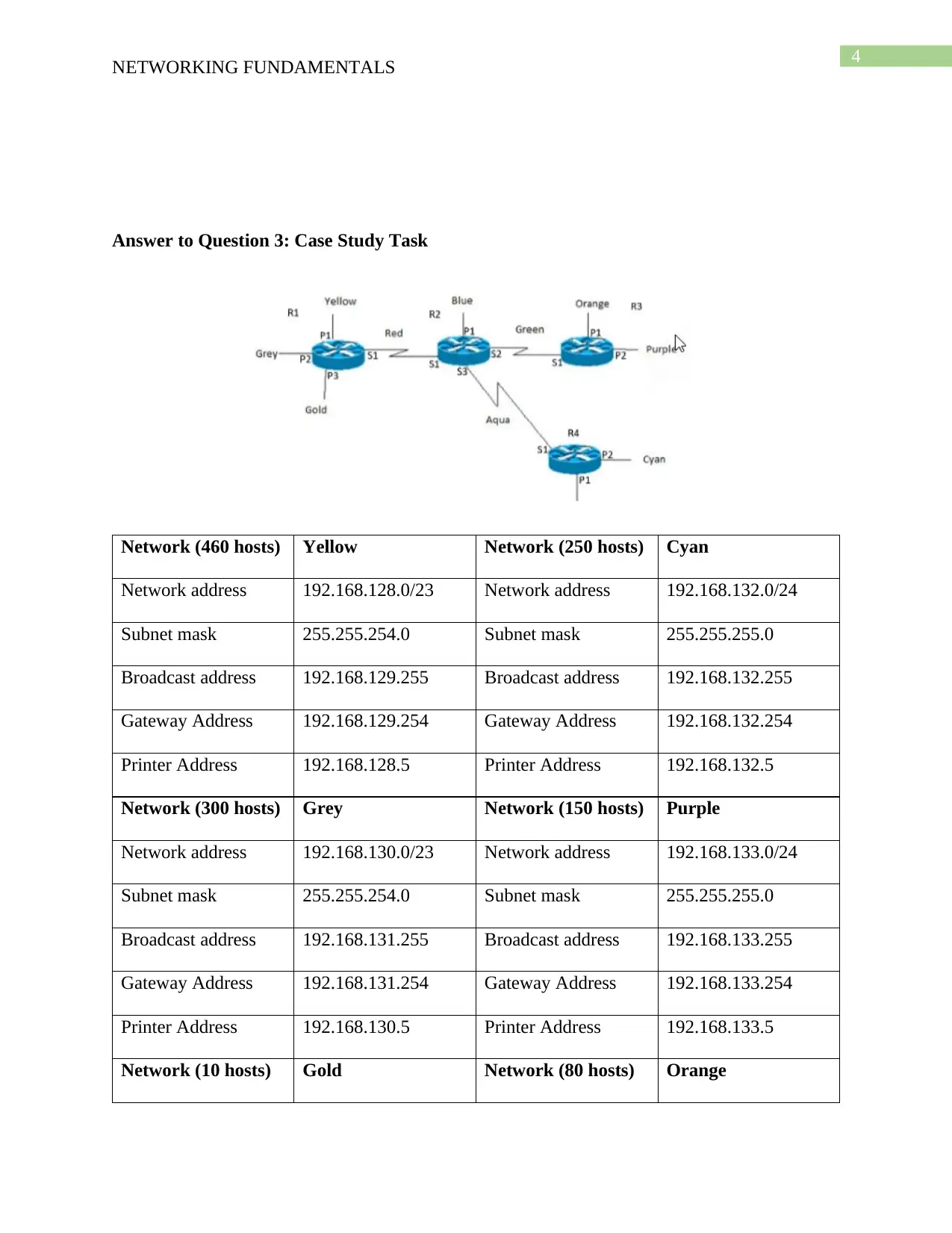Networking Fundamentals Assessment Item 2 - Network Analysis
VerifiedAdded on 2022/09/22
|7
|809
|22
Homework Assignment
AI Summary
This document is a solution to a Networking Fundamentals assignment. It begins with an overview of the OSI model, detailing the functions of each of the seven layers, including the physical, data link, network, transport, session, presentation, and application layers. The assignment then provides solutions to hands-on projects. Furthermore, the assignment addresses a case study, providing detailed network configurations for various networks, including subnet masks, broadcast addresses, gateway addresses, and printer addresses. The configurations cover a range of network sizes and includes WAN configurations with specific IP address assignments for routers. The assignment is completed with a bibliography of sources used.

Running head: NETWORKING FUNDAMENTALS
Networking Fundamentals
Assessment Item 2
Name of the Student
Name of the University
Author’s Note
Networking Fundamentals
Assessment Item 2
Name of the Student
Name of the University
Author’s Note
Paraphrase This Document
Need a fresh take? Get an instant paraphrase of this document with our AI Paraphraser

1
NETWORKING FUNDAMENTALS
Answer to Question 1:
There are seven layers that are involved in the OSI model. The physical layer is used for
transferring the communication signals through different kinds of medium, and it is used to
receive signals that are coming from this medium (Alhamedi et al, 2014). The data link layer is
used to establish the connection between the data that can be transmitted. The Media Access
control sub layer is used to establish the physical address the host of a particular network. It is
used to take the MAC address for a certain kind of network (Bora et al., 2014). Network layer is
used to manage the logical address of the information that can distribute in to the packets and
also the submission of those packets at the exact end. The logical address is used detect a system
that is situated in a certain network system. The transport layer handles many kind of reliable or
unreliable delivery of the information to the end (He et al., 2016). It is also used to segregate the
data in to tiny number of packets. Session layer is responsible for establishing the session sin the
network systems. The presentation layer converts the data into specific format. In the application
layer a request related to the web are transferred.
The software layer of the OSI layer is used to establish the connection between the links.
The hardware layer is used to establish the contact by sending different kinds of medium.
The network layer is also known as the internet layer. In this layer the IP address and also
the routing in practical format (Bora et al., 2014). When the data is transferred from one end to
another then a LAN to that node to another node to the other LANs. That is why it is also called
internet layer.
NETWORKING FUNDAMENTALS
Answer to Question 1:
There are seven layers that are involved in the OSI model. The physical layer is used for
transferring the communication signals through different kinds of medium, and it is used to
receive signals that are coming from this medium (Alhamedi et al, 2014). The data link layer is
used to establish the connection between the data that can be transmitted. The Media Access
control sub layer is used to establish the physical address the host of a particular network. It is
used to take the MAC address for a certain kind of network (Bora et al., 2014). Network layer is
used to manage the logical address of the information that can distribute in to the packets and
also the submission of those packets at the exact end. The logical address is used detect a system
that is situated in a certain network system. The transport layer handles many kind of reliable or
unreliable delivery of the information to the end (He et al., 2016). It is also used to segregate the
data in to tiny number of packets. Session layer is responsible for establishing the session sin the
network systems. The presentation layer converts the data into specific format. In the application
layer a request related to the web are transferred.
The software layer of the OSI layer is used to establish the connection between the links.
The hardware layer is used to establish the contact by sending different kinds of medium.
The network layer is also known as the internet layer. In this layer the IP address and also
the routing in practical format (Bora et al., 2014). When the data is transferred from one end to
another then a LAN to that node to another node to the other LANs. That is why it is also called
internet layer.

2
NETWORKING FUNDAMENTALS
Answer to Question 2:
Hands-On Project 2-2
Hands-On Project 2-3
NETWORKING FUNDAMENTALS
Answer to Question 2:
Hands-On Project 2-2
Hands-On Project 2-3
⊘ This is a preview!⊘
Do you want full access?
Subscribe today to unlock all pages.

Trusted by 1+ million students worldwide

3
NETWORKING FUNDAMENTALS
Hands-On Project 2-7
NETWORKING FUNDAMENTALS
Hands-On Project 2-7
Paraphrase This Document
Need a fresh take? Get an instant paraphrase of this document with our AI Paraphraser

4
NETWORKING FUNDAMENTALS
Answer to Question 3: Case Study Task
Network (460 hosts) Yellow Network (250 hosts) Cyan
Network address 192.168.128.0/23 Network address 192.168.132.0/24
Subnet mask 255.255.254.0 Subnet mask 255.255.255.0
Broadcast address 192.168.129.255 Broadcast address 192.168.132.255
Gateway Address 192.168.129.254 Gateway Address 192.168.132.254
Printer Address 192.168.128.5 Printer Address 192.168.132.5
Network (300 hosts) Grey Network (150 hosts) Purple
Network address 192.168.130.0/23 Network address 192.168.133.0/24
Subnet mask 255.255.254.0 Subnet mask 255.255.255.0
Broadcast address 192.168.131.255 Broadcast address 192.168.133.255
Gateway Address 192.168.131.254 Gateway Address 192.168.133.254
Printer Address 192.168.130.5 Printer Address 192.168.133.5
Network (10 hosts) Gold Network (80 hosts) Orange
NETWORKING FUNDAMENTALS
Answer to Question 3: Case Study Task
Network (460 hosts) Yellow Network (250 hosts) Cyan
Network address 192.168.128.0/23 Network address 192.168.132.0/24
Subnet mask 255.255.254.0 Subnet mask 255.255.255.0
Broadcast address 192.168.129.255 Broadcast address 192.168.132.255
Gateway Address 192.168.129.254 Gateway Address 192.168.132.254
Printer Address 192.168.128.5 Printer Address 192.168.132.5
Network (300 hosts) Grey Network (150 hosts) Purple
Network address 192.168.130.0/23 Network address 192.168.133.0/24
Subnet mask 255.255.254.0 Subnet mask 255.255.255.0
Broadcast address 192.168.131.255 Broadcast address 192.168.133.255
Gateway Address 192.168.131.254 Gateway Address 192.168.133.254
Printer Address 192.168.130.5 Printer Address 192.168.133.5
Network (10 hosts) Gold Network (80 hosts) Orange

5
NETWORKING FUNDAMENTALS
Network address 192.168.134.224/28 Network address 192.168.134.0/25
Subnet mask 255.255.255.240 Subnet mask 255.255.255.128
Broadcast address 192.168.134.239 Broadcast address 192.168.134.127
Gateway Address 192.168.134.238 Gateway Address 192.168.134.126
Printer Address 192.168.134.230 Printer Address 192.168.134.5
Network (30 hosts) Silver Network (60 hosts) Blue
Network address 192.168.134.192/27 Network address 192.168.134.128/26
Subnet mask 255.255.255.224 Subnet mask 225.255.255.192
Broadcast address 192.168.134.223 Broadcast address 192.168.134.191
Gateway Address 192.168.134.222 Gateway Address 192.168.134.190
Printer Address 192.168.134.197 Printer Address 192.168.134.133
Network (WAN) Red Network (WAN) Green
Network address 192.168.134.248/30 Network address 192.168.134.244/30
Subnet mask 255.255.255.252 Subnet mask 255.255.255.252
Broadcast address 192.168.134.251 Broadcast address 192.168.134.247
R1S1 to R2S2 192.168.134.249 to
192.168.134.250
R2S2 to R3S1 192.168.134.245 to
192.168.134.246
Network (WAN) Aqua
Network address 192.168.134.240/30 R2S3 to R4S1 192.168.134.241 to
192.168.134.242
Subnet mask 255.255.255.252
Broadcast address 192.168.134.243
NETWORKING FUNDAMENTALS
Network address 192.168.134.224/28 Network address 192.168.134.0/25
Subnet mask 255.255.255.240 Subnet mask 255.255.255.128
Broadcast address 192.168.134.239 Broadcast address 192.168.134.127
Gateway Address 192.168.134.238 Gateway Address 192.168.134.126
Printer Address 192.168.134.230 Printer Address 192.168.134.5
Network (30 hosts) Silver Network (60 hosts) Blue
Network address 192.168.134.192/27 Network address 192.168.134.128/26
Subnet mask 255.255.255.224 Subnet mask 225.255.255.192
Broadcast address 192.168.134.223 Broadcast address 192.168.134.191
Gateway Address 192.168.134.222 Gateway Address 192.168.134.190
Printer Address 192.168.134.197 Printer Address 192.168.134.133
Network (WAN) Red Network (WAN) Green
Network address 192.168.134.248/30 Network address 192.168.134.244/30
Subnet mask 255.255.255.252 Subnet mask 255.255.255.252
Broadcast address 192.168.134.251 Broadcast address 192.168.134.247
R1S1 to R2S2 192.168.134.249 to
192.168.134.250
R2S2 to R3S1 192.168.134.245 to
192.168.134.246
Network (WAN) Aqua
Network address 192.168.134.240/30 R2S3 to R4S1 192.168.134.241 to
192.168.134.242
Subnet mask 255.255.255.252
Broadcast address 192.168.134.243
⊘ This is a preview!⊘
Do you want full access?
Subscribe today to unlock all pages.

Trusted by 1+ million students worldwide

6
NETWORKING FUNDAMENTALS
Bibliography
Alhamedi, A. H., Snasel, V., Aldosari, H. M., & Abraham, A. (2014, July). Internet of things
communication reference model. In 2014 6th International Conference on
Computational Aspects of Social Networks (pp. 61-66). IEEE.
Bora, G., Bora, S., Singh, S., & Arsalan, S. M. (2014). OSI reference model: An
overview. International Journal of Computer Trends and Technology, 7(4), 214-218.
He, L., Zhang, X., Cheng, Z., & Jiang, Y. (2016, July). Design and implementation of SDN/IP
hybrid space information network prototype. In 2016 IEEE/CIC International
Conference on Communications in China (ICCC Workshops) (pp. 1-6). IEEE.
Kumar, S., Dalal, S., & Dixit, V. (2014). The OSI model: Overview on the seven layers of
computer networks. International Journal of Computer Science and Information
Technology Research, 2(3), 461-466.
NETWORKING FUNDAMENTALS
Bibliography
Alhamedi, A. H., Snasel, V., Aldosari, H. M., & Abraham, A. (2014, July). Internet of things
communication reference model. In 2014 6th International Conference on
Computational Aspects of Social Networks (pp. 61-66). IEEE.
Bora, G., Bora, S., Singh, S., & Arsalan, S. M. (2014). OSI reference model: An
overview. International Journal of Computer Trends and Technology, 7(4), 214-218.
He, L., Zhang, X., Cheng, Z., & Jiang, Y. (2016, July). Design and implementation of SDN/IP
hybrid space information network prototype. In 2016 IEEE/CIC International
Conference on Communications in China (ICCC Workshops) (pp. 1-6). IEEE.
Kumar, S., Dalal, S., & Dixit, V. (2014). The OSI model: Overview on the seven layers of
computer networks. International Journal of Computer Science and Information
Technology Research, 2(3), 461-466.
1 out of 7
Related Documents
Your All-in-One AI-Powered Toolkit for Academic Success.
+13062052269
info@desklib.com
Available 24*7 on WhatsApp / Email
![[object Object]](/_next/static/media/star-bottom.7253800d.svg)
Unlock your academic potential
Copyright © 2020–2025 A2Z Services. All Rights Reserved. Developed and managed by ZUCOL.


